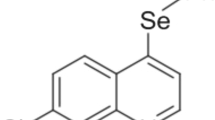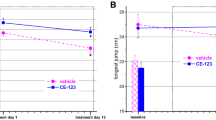Summary
Physostigmine and tetrahydroaminoacridine (THA) have been reported to improve cognitive function in patients with Alzheimer's disease. Two experiments were conducted to examine the effects of these anticholinesterase agents on learning in aged rats pretreated chronically with barbital. In the first experiment animals received barbital in their drinking water for 46 weeks. Controls were given only water. On days 100–104 of abstinence, when the animals were 20 months old, acquisition of the Morris maze task was initiated after treatment with physostigmine. It was found that physostigmine improved learning of the maze task in control but not barbital treated rats. In the second experiment animals received barbital solution or water as in experiment one. On days 100–103 of abstinence they were injected with THA before being tested in the Morris water maze. It was found that THA improved learning in both barbital treated and control rats. These results corroborate clinical findings of improved cognitive function following treatment with THA, and suggest that the therapeutic effects of THA may be mediated by mechanisms distinct from cholinesterase inhibition. Furthermore chronic barbital treatment could be used as a model to study cognitive disturbances in experimental animals.
Similar content being viewed by others
References
Albin RL, Young AB, Penney JB (1988) Tetrahydro-9-aminoacridine (THA) interacts with the phencyclidine (PCP) receptor site. Neurosci Lett 88: 303–307
Drukarch B, Leysen JE, Stoof JC (1988) Further analysis of the neuropharmacological profile of 9-amino-1,2,3,4-tetrahydroacridine (THA) an alleged drug for the treatment of Alzheimer's disease. Life Sci 42: 1011–1017
Elinder F, Mohammed AK, Winblad B, Århem P (1989) Effects of THA on ionic currents in myelinated axons ofXenopus laevis. Eur J Pharmacol 164: 599–602
Flood JF, Cherkin A (1988) Effect of acute arecoline, tacrine and arecoline+tacrine posttraining administration on retention in old mice. Neurobiol Aging 9: 5–8
Freeman SH, Lau W-M, Zilagyi M (1988) Blockade of a cardiac K+ channel by tacrine: interactions with muscarinic and adenosine receptors. Eur J Pharmacol 154: 59–65
Hagan JJ, Morris RGM (1988) The cholinergic hypothesis of memory: a review of animal experiments. In: Iversen LL, Iversen SD, Snyder SH (eds) Handbook of psychopharmacology, vol. 20. Plenum, New York, pp. 237–323
Haroutunian V, Kanof P, Davis KL (1985) Pharmacological alleviation of cholinergic lesion induced memory deficits in rats. Life Sci 37: 945–952
Ho IK, Harris RA (1981) Mechanism of action of barbiturates. Annu Rev Pharmacol Toxicol 21: 83–111
Mohammed AK, Wahlström G, Tiger G, Björklund PE, Stenström A, Magnusson O, Archer T, Fowler C, Nordberg A (1987) Impaired performance of rats in the Morris swim-maze test late in abstinence following long-term sodium barbital treatment. Drug Alcohol Dep, 20: 203–212
Mohs RC, Davies BM, Mathè AA, Rosen WG, Johns CA, Greenwald BS, Horwvath TB, Davies KL (1985) Intravenous and oral physostigmine in Alzheimer's disease. Interdiscip Top Gerontol 20: 140–152
Morris RGM (1984) Development of a water-maze procedure for studying spatial learning in the rat. J Neurosci Methods 11: 47–60
Murray CK, Fibiger HC (1985) Learning and memory deficits after lesions of the nucleus basalis magnocellularis: reversal by physostigmine. Neuroscience 14: 1025–1032
Nabeshima T, Yoshida S, Kameyana T (1988) Effects of the novel compound NIK-247 on impairment of passive avoidance response in mice. Eur J Pharmacol 154: 263–269
Nilsson L, Adem A, Hardy J, Winblad B, Nordberg A (1987) Do tetrahydroaminoacridine (THA) and physostigmine restore acetylcholine release in Alzheimer brains via nicotinic receptors? J Neural Transm 70: 357–368
Nordberg A, Wahlström G (1977) Effect of long-term forced oral barbital administration on endogenous acetylcholine in different regions of rat brain. Eur J Pharmacol 43: 237–242
Nordberg A, Wahlström G (1981) Changes in cholinergic function in rat brain late in abstinence after chronic barbital treatment. Drug Alcohol Depend 7: 51–61
Nordberg A, Wahlström G, Larsson C (1980) Increased number of muscarinic binding sites in brain following chronic barbiturate treatment to rat. Life Sci 26: 231–237
Nordberg A, Nilsson-Håkonsson L, Adem A, Lai Z, Winblad B (1988) Multiple actions of THA on cholinergic neurotransmission in Alzheimer brains. In: Iqbal K, Wisniewski H, Winblad B (eds) Proceedings of the First International Conference on Alzheimer's Disease and Related Disorder. Las Vegas, September 6–10, 1988
Osterrieder W (1987) 9-amino-1,2,3,4-tetrahydroaminoacridine (THA) is a potent blocker of cardiac potassium channels. Br J Pharmacol 92: 521–526
Pearce BD, Potter LT (1987) Effects of tetrahydroaminoacridine on M1 and M2 muscarinic receptors. Neurosci Lett 88: 281–285
Perry EK, Smith CJ, Court JA, Bonham JR, Rodway M, Atack JR (1988) Interaction of 9-amino-1,2,3,4-tetrahydroaminoacridine (THA) with human cortical nicotinic and muscarinic receptor binding in vitro. Neurosci Lett 91: 211–216
Reiner PB, McGeer EG (1988) THA increases action potential duration of central histamine neurons in vitro. Eur J Pharmacol 155: 265–270
Sahakian BJ (1988) Cholinergic drugs and human cognitive performance. In: Iversen LL, Iversen SD, Snyder SH (eds) Handbook of psychopharmacology, vol. 20: Plenum, New York, pp. 393–424
Schauf CL, Sattin A (1987) Tetrahydroaminoacridine blocks potassium channels and inhibits sodium inactivation in Myxicola. J Pharmacol Exp Ther 243: 609–613
Sherman KA, Messamore E (1988) Blood cholinesterase inhibition as a guide to the efficacy of putative therapies for Alzheimer's dementia: comparison of tacrine and physostigmine. In: Giacobini E, Becker R (eds) Current research in Alzheimer therapy. Taylor and Francis New York, pp. 73–76
Summers WK, Majorski LV, Marsh GM, Tachiki K, Kling A (1986) Oral tetrahydroaminoacridine in longterm treatment of senile dementia, Alzheimer type. N Engl J Med 315: 1241–1245
Wahlström G (1974) Withdrawal in the rat after long-term forced oral barbital administration. Acta Pharmacol Toxicol 35: 131–144
Wahlström G (1977) Disturbances of the activity rest pattern in rats during the abstinence after chronic barbital or ethanol treatments. In: Koella WP, Levein P (eds) Sleep 1976. 3rd European Congress on Sleep Research, Montpellier, 1976. S. Karger, Basel, pp 384–387
Wahlström G (1978) Addictive drugs and some neurotransmitters (acetylcholine and gamma-aminobutyric acid). In: Fishman J (ed) The bases of addiction. Verlag Chemie, Berlin, pp. 353–374
Wahlström G, Larsson R (1977) Activity pattern and convulsions in the abstinence period after barbital treatment in the rat. Pharmacol Biochem Behav 6: 187–192
Wahlström G, Nordberg A (1978) Decreased brain weights in rats after long-term barbital treatments. Life Sci 23: 1583–1590
Author information
Authors and Affiliations
Rights and permissions
About this article
Cite this article
Mohammed, A.K., Wahlström, G., Archer, T. et al. Learning deficits in aged rats pretreated chronically with barbital and tested late in abstinence: alleviation by tetrahydroaminoacridine. J Neural Transm Gen Sect 2, 285–294 (1990). https://doi.org/10.1007/BF02252923
Received:
Accepted:
Issue Date:
DOI: https://doi.org/10.1007/BF02252923




